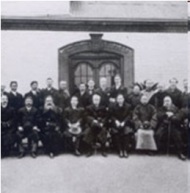Drugs: legal framework
Background

The international control on narcotics and psychotropic substances goes back to the beginning of the 20th century. Worried about the high level of opium consumption at the time and its health consequences, several countries gathered for the first time to discuss the drug problem in the Shanghai Opium Commission, in 1909.
To that date opium was commercialized, mainly by the English, as a means of payment for products, replacing silver which was scarce in trading since 1880. Opium was bought frequently in India and resold to the Chinese, and it once accounted for one sixth of the English external resources. From this trade an epidemic was created, whose harmful consequences to the people's health started to become evident: in 1906, approximately a quarter of the Chinese adult male population was dependent on opium. This was the biggest epidemic of drug abuse ever faced by a country in history.
From the Shanghai Commission, controls started to become stricter, especially after the 1st World War, under the League of Nations' coordination. The result was a 70% reduction on opium production within 100 years, while global population in the same period quadruplicated. Had this control effort not happened, and if opium consumption increase followed the natural population growth, today the consumption could be 13 times higher than actual current numbers.
From the first control strategies, following the diversification of drugs and the increased narcotics and psychotropic substances synthesis capacity, countries, now within the United Nations, signed the three conventions on drugs that are today the legal reference for all signatory countries.
Conventions
The three United Nations drug control conventions are complementary. The main purpose of the two earlier conventions is to systemize the measures for international control with the goal of ensuring the availability of narcotics and psychotropic substances for medical and scientific use, and to prevent its distribution through illicit channels. They also include general measures on traffic and drug abuse.
Single Convention on Narcotic Drugs of 1961 as amended by the 1972 Protocol
This Convention aims to combat drug abuse by coordinated international action. There are two forms of intervention and control that work together. First, it seeks to limit the possession, use, trade in, distribution, import, export, manufacture and production of drugs exclusively to medical and scientific purposes. Second, it combats drug trafficking through international cooperation to deter and discourage drug traffickers.
Full text in English | Spanish | French | Russian | Chinese | Arabic)
List of Narcotic Drugs under International Control (Yellow List)
Convention on Psychotropic Substances of 1971
The Convention establishes an international control system for psychotropic substances. It responded to the diversification and expansion of the spectrum of drugs of abuse and introduced controls over a number of synthetic drugs according to their abuse potential on the one hand and their therapeutic value on the other.
Full text in English | Spanish | French | Russian | Chinese | Arabic)
List of Psychotropic Substances under International Control (Green List)
United Nations Convention against Illicit Traffic in Narcotic Drugs and Psychotropic Substances of 1988
This Convention provides comprehensive measures against drug trafficking, including provisions against money laundering and the diversion of precursor chemicals. It provides for international cooperation through, for example, extradition of drug traffickers, controlled deliveries and transfer of proceedings.
Full text in English | Spanish | French | Russian | Chinese | Arabic)
20th Special Session of the General Assembly on the World drug problem
From the 8th to the 10th of June 1998, the 20th Special Session of the UN's General Assembly (UNGASS), in New York, discussed the world drug problem. The countries established a new agenda for the international community, with the adoption of three basic documents: a political declaration, a declaration on the guiding principles for drug demand reduction and a resolution with measures to enhance international cooperation (
document's full text).
By approving the political declaration, the UN Member States committed to obtain measurable results on illegal drugs demand and supply reduction up to 2008.
In 2009, the UN Commission on Narcotic Drugs (CND) analyzed the ten previous years concerning the progress achieved in the fulfillment of the objectives and goals established in the 1998 UNGASS.
A report presented by UNODC stated that significant progress was achieved in that ten-year period, but in some areas and regions the UN Member States had not fully reached the objectives and goals mentioned in the political declaration. Still, a global trend of stabilization in production, traffic and consumption of drugs was observed.
During the revision meeting, the countries decided to renew the 1998 UNGASS commitment, signing a document that established as goal "to minimize and, eventually, eliminate the availability and use of illicit drugs" up to 2019.
Political Declaration and Plan of Action on International Cooperation towards an Integrated and Balanced Strategy to Counter the World Drug Problem (page 37)
Resolutions and decisions
Click here to access all drug-related resolutions and decisions adopted by the UN General Assembly, the Economic and Social Council (ECOSOC) and the Commission on Narcotic Drugs (CND).
National Legislation on Drugs
 Argentina
Argentina
Secretary of Programmes for Prevention of Drug Addiction and Fight against Drug Trafficking (SEDRONAR) (in Spanish)
 Brasil
Brasil
National Secretary of Drug Policies (SENAD)
 Chile
Chile
National Council for Narcotics Control Board - Government of Chile (CONACE) (in Spanish)
 Paraguay
Paraguay
National Anti-Drug Secretary (SENAD) (in Spanish)
 Uruguay
Uruguay
National Drug Board (in Spanish)